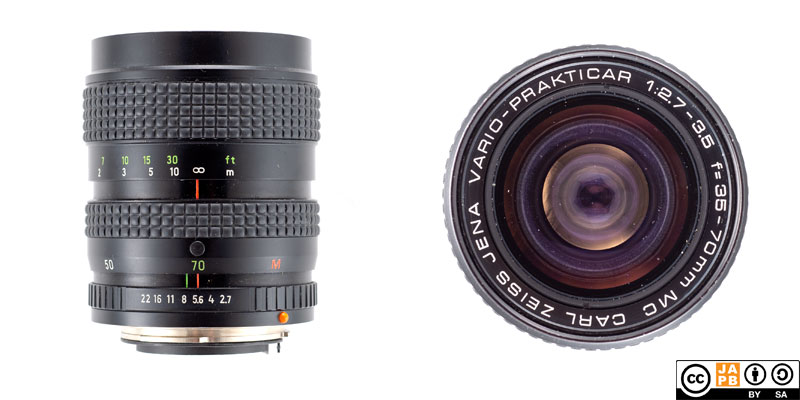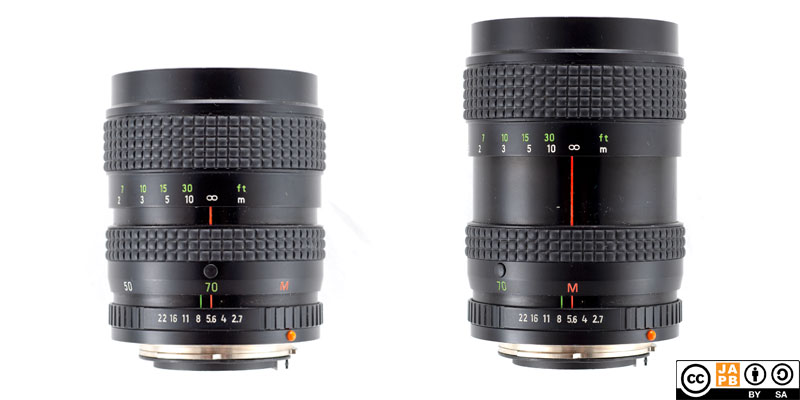Pekka Buttler, 03/2023

Specifications
The table below summarizes the lens’ key specifications (measurements are based on the pictured sample):
| Brand: | Carl Zeiss Jena | Lens name | Vario-Prakticar 1:2,7-3.5 f=35–70mm MC |
| Focal length(s) 1 | 35–70 mm | Angle-of-view 2 | 64 ° – 34 ° |
| Maximum Aperture | f/2.7–3.5 | In Production | 1982–1990 |
| Lens mounts | Praktica B | Subfamily (if applicable) | –– |
| Length 3 | 75,4 mm | Diameter 4 | 64,4 mm |
| Filter ring diameter | 58 mm | Weight | 381 grams |
| Lens element count | 9 | Lens group count | 8 |
| Aperture blades (S/R/C) 5 | 6 star-shaped | Focus throw | 160 ° |
| Minimum focusing distance | 80 cms | Maximum magnification | 1:9,3 |
| Has manual aperture ring | YES | Has Manual focus ring | YES |
| Aperture mechanism type | Automatic | Aperture click stops 6 | 2.7•4•5.6•8•11•16•22 |
Further notes:
• Prakticar is the name given to all Carl Zeiss Jena and Pentacon (and many other) lenses designed for the Praktica B mount. This lens’ name is Vario-Prakticar (‘Vario’ was the preferred term for Zooms in Germany), but the corresponding m42 lens goes by the name ‘Vario-Pancolar’ (even though this zoom lens had very littler in common with Pancolar designs, which was Carl Zeiss Jena’s post-1960 name for double-Gauss / Planar type lenses.)
• Alike all Praktica B mount lenses, this lens has three electronic contacts that it uses to communicate selected aperture to the camera body and a physical aperture stop-down lever.
• The 35-70 mm Vario-Prakticar/Vario-Pancolar was manufactured in only one cosmetic version.
• While never having been produced in large numbers, this was one or the Praktica B-system’s key lenses and was kept in production the entire running time of the system (1978–1990)
• It’s a two-touch zoom with one ring for focal length and one for focusing (and one for aperture). The lens is very near parfocal.
• The lens is at its shortest at 50-70 mm, but gets longer towards 35 mm. The lens also changes length as you focus and the front filter thread rotates when focusing.
• The lens offers a built-in macro-function (zoom to 70 mm, press a button, and enter a macro mode), at which the minimum focusing distance is 27,5 cm and the maximum magnification is about 1:2,9

History of Carl Zeiss Jena
There are few names in camera optics more illustrious than that of Carl Zeiss. The company was founded in the German town of Jena in 1846 by Carl Zeiß (hence: ‘Carl Zeiss Jena‘). During 1846–1945 there are few major developments in lens optics that the company was not involved in. Names that are even today well-known in optics – such as Planar (1896), Tessar (1902), Sonnar (1929), and Biotar (1939) (as well as many names that only optics-buffs know) – were the product of Zeiss’ first century of technological innovation.
After the Second World War Germany was divided into a Soviet zone (subsequently: East Germany) and the west-allied zones (subsequently: West Germany). While the Zeiss works resided in Jena (optics and glasses) and Dresden (cameras), which were in the Soviet sector, a contingent of Zeiss managers decided to move west and ended up setiting up shop in the small town of Oberkochen in the American sector under the name of Opton Optische Werke Oberkochen GmbH. As the relations between the former allied deteriorated and the split into East and West Germany became all the more real, the Oberkochen works changed their name first to Zeiss-Opton and later to Carl Zeiss.
What ensued was a lengthy international trademark dispute with both Zeiss’ (Jena and Oberkochen) laying claim to the name ‘Carl Zeiss’. The resulting stalemate – emblematic of the Cold War in its entirety – resulted in that Carl Zeiss Opton was allowed to use the name Carl Zeiss in the West, but had to use the Opton brand in the East bloc, whereas Carl Zeiss Jena was the only real Carl Zeiss as far as the east bloc was concerned, but could – mostly – not use the Carl Zeiss -name for exports to the West 7. The fact remains however, that – starting in 1946 from a shared base – Jena and Oberkochen developed as two independent companies for more than 40 years. After German reunification also Zeiss East and Zeiss West were united again, and have since again been at the undoubtable forefront of lens development.
This lens harkens to the time of the cold-war and the East/West split. During the entire Cold War period, VEB Carl Zeiss Jena was seen by the country’s leadership both as a paragon of the East German technology industry and a showcase of the socialist/communist system as well as a major source of exports (and hence, western currencies). Within the centrally directed economy’s hierarchy, Carl Zeiss Jena therefore had a more prestigious role than other East German optics manufacturers (prominently Meyer-Optik Görlitz and, later, Pentacon), meaning that Carl Zeiss Jena received privileged access to tools and materiel (including the first computer in East Germany) and that its products were always considered the premium alternative.
History of the Vario-Pancolar/Vario Prakticar
As is obvious to anyone who has ever taken camera lenses apart, Zoom lenses (also sometimes referred to as ‘variable focusing’ or ‘varifocal’ lenses) add a whole new level of complexity to lens design and construction. Importantly, only in the 1960s was the 35 mm camera industry advanced enough to be able to routinely tackle zoom lens design and manufacture. The 1970s saw standard zoom lenses rise in popularity and even take over as kit lenses (the lens that came bundled with a new camera). But the German camera industry had fallen behind in this trend.
While Germany had once been the forefront of zoom lens development, the 1970s saw the East German camera industry desperate enough to rebrand Japanese and Korean zoom lenses (just to be able to offer customers what they wanted: zooms). Everyone at Carl Zeiss Jena agreed that this could not stand! Hence, the designers at Carl Zeiss Jena set out to design a set of zoom lenses. The result were the 35–70 standard zoom (this lens) and a 80–200/4 tele zoom. Both are considered very good zoom lenses (for their era), but …
Praktica lenses continued to be sold bundled with Japanese and Korean Zoom lenses (or nifty fifties). Why? Firstly, the designs from Jena were optically rather ambitious, and were never really intended as simple kit lenses. Secondly, Carl Zeiss Jena clearly had problems in ramping up production, because there were simply not enough Vario-Prakticars to go around. This was especially annoying to East German Photography enthusiasts, as most of the Zooms were reserved for exports into the West. As a result, this lens is relatively rare.
Versions
The 35–70 Vario-Prakticar was only ever produced in one version.
Adapting
This lens cannot be used natively on any current SLR or dSLRs. To use it in its native environment, you will need a Praktica B mount film body. Luckily there are a lot of those available, and many of them are still in perfect working order.
Thanks to being a fully manual lens (manual aperture, manual focus), the lens can be adapted to all mirrorless cameras using a suitable adapter. Moreover, Praktica B lenses are so uncomplicated that a simple ‘dumb adapter’ will do the job perfectly (The electronic contacts communicate only from the lens to the camera and do not impinge on adapting). However, due to that the Praktica B mount never was so successful, one should not expect special adapters (helicoid adapters, tilt/shift adapters) to be easily available. Alternatively, one can choose to daisy-chain adapters (e.g. Praktica B->Canon EF; Canon EF –> mirrorless) which not only opens up possibilities for special adapters, but also allows using speed boosters for those photographers that use smaller than full-frame sensors.
Using Praktica B lenses on dSLRs can also be an easy option, depending on which dSLR.
• Canon EF has the shortest flange focal distance among full-frame dSLR’s and Canon’s wide range of dSLRs are able to mount Praktica B lenses perfectly using a suitable adapter ring.
• With other dSLR mounts (Minolta/Sony A; Pentax K; Nikon F) the relationship between flange focal differences becomes an issue, leading to that adapting will necessitate an adapter that uses corrective optics to allow reaching infinity focus
Footnotes
- Focal length is (unless stated otherwise) given in absolute terms, and not in Full-frame equivalent. For an understanding of whether the lens is wide/tele, see ‘Angle-of-view’. ↩︎
- Picture angle is given in degrees (based on manufacturers’ specs) and concerns the diagonal picture angle. Rule of thumb:
> 90 ° ==> Ultra-wide-angle
70–90 ° ==> Wide-angle
50–70 ° ==> Moderate wide-angle
40–50 ° ==> ‘Standard’ or ‘normal’ lens
20–40 ° ==> Short tele lens
10-20 ° ==> Tele lens
5-10 ° ==> Long tele lens
< 5 ° ==> Ultra-tele lens ↩︎ - Length is given from the mount flange to the front of lens at infinity. ↩︎
- Diameter excludes protrusions such as rabbit ears or stop-down levers. ↩︎
- S=straight; R=rounded; C=(almost)circular at all apertures. ↩︎
- Numbers equal aperture values on aperture ring; • intermediate click; – no intermediate click. ↩︎
- Online one can find many lengthy and heated disputes stating that only Jena/Oberkochen is the true Carl Zeiss. While many of these discussions are riddled with misconceptions and a poor grasp of facts and timings, they largely also tend to be tainted by ideologies. Those discussions that focus on claims of one or the other Zeiss not really having rights to using designs developed at pre-war Zeiss are especially ludicrous because after the war practically the entire patent catalogue of pre-war German patents was given freely to everyone (the allied saw this as a form of reparations), hence also kickstarting the Japanese optics industry’s ascendancy (the Japanese optics companies were the most avid users of German optics patents). ↩︎